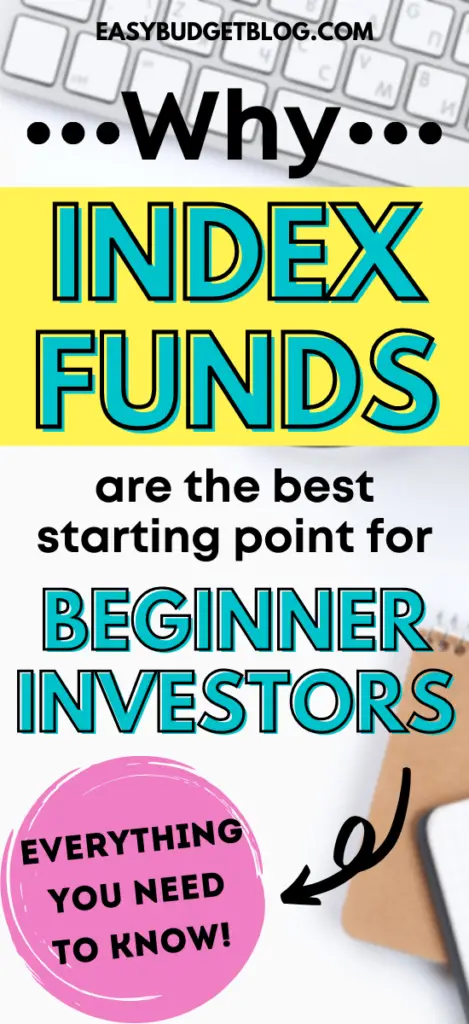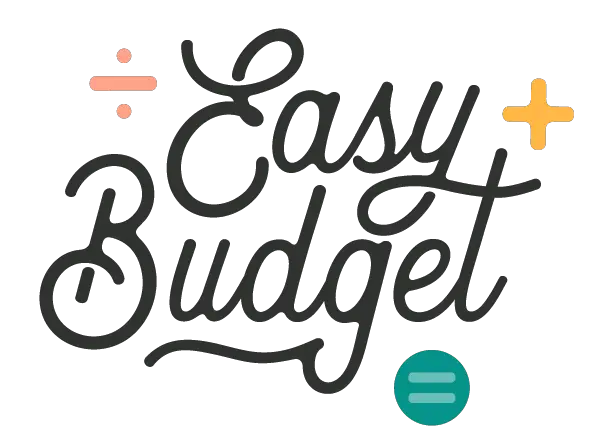This post may contain affiliate links where I earn a commission, at no additional cost to you, if you decide to make a purchase after clicking on a link. Please see our Disclosure Policy for full details. Thank you for your support!
Let me guess . . . You are new to getting your finances together and finally ready to dive into the world of investing. However, you feel totally clueless and a little nervous about getting started. After all, it seems complicated . . . like something only really smart and rich people do. Today I’m going to show you that not only is investing exciting and something everyday men and women can do, it’s also pretty easy! I’ll teach you what index funds are and why they’re the best starting point for beginner investors.

One of the biggest mistakes people make is thinking that in order to invest, they have to be some Stanford-trained genius or that they’ll have to put years into learning the ins-and-outs of the stock market.
Nothing could be further from the truth! Investing in index funds is something regular Janes and Joes like you and me can do, and it’s pretty quick to learn how to get started.
But don’t be fooled, index funds can make small but consistent investors millionaires by the time they retire. They are powerful.
Index funds are the ticket to stupid simple, great return on investment, autopilot investing. And by the way, index funds are not just for beginners. In fact, many millionaires and wealthy people choose to keep some of their portfolio in index funds as well. Keep reading and you’ll understand why.

What is an Index Fund?
First, let’s talk about what an index fund is (because they don’t teach this stuff in school).
You probably know what a stock is. It’s a tiny piece of a publicly traded company. When you buy a stock, you are buying a tiny piece of the company. As the company grows, the stock price increases, and your shares go up in value too! In this way, you make money, or receive a return on your investment.
There’s more, but first I must cover this…
What is an Index?
Before I talk any more about what an index fund is, I must explain what an index is. An index is a specially selected group of stocks that acts as an indicator for the overall stock market. So for example, the S&P 500 index follows the stock price of 500 of the top companies in America. Looking up this index and how it’s performing will give you information on how these top 500 companies are doing, and give you a good idea of how the overall stock market is performing as well. Thus, indexes are used for measuring the market in various ways.
Now, what if instead of picking and buying individual stocks, you could buy a whole bunch of stocks all at once in one transaction? What if you could simply buy a little bit of all the stocks in one of these indexes? That would be pretty convenient, right?
Here’s why: If you pick 1-2 stocks to invest all your money in (i.e. Apple, Disney, Costco), you are at risk of losing all your money if the stock goes under. If you had your money in 500 diverse stocks all at once, you’re much less likely to lose your money due to a company going under!
It goes back to the old adage: don’t keep all your eggs in one basket.
Well, you’re in luck, this is exactly what index funds allow you do to: purchase a small part of all the stocks in an index all at once in one transaction, thus spreading out your investment across hundreds of diversified companies.
One question you’re bound to be asking yourself right now is, what’s the difference between a mutual fund and an index fund? They are very similar, but there are some very key differences you need to know.
A mutual fund is a huge grouping of stocks and investments chosen by a professional asset manager of some kind. They choose stocks they think will do well and create a mutual fund, and then you purchase some of the fund and get a little piece of all the investments inside, just like an index fund. Here’s the problem though: mutual funds are actively managed by a professional. Index funds are passively managed because the stocks within are simply based on the current index. Because of this, mutual funds tend to be higher fee (1-5% per year), and index funds tend to be very low fee (.01-.07% per year). And here’s the kicker: mutual funds almost never outperform index funds.
Don’t get me wrong, mutual funds are still great. A lot of people choose to invest in them through their financial professional so someone else will take investing off their plate. However, I wish more people would take a few minutes to learn about index funds, because they typically perform the same or better than mutual funds and the high fees in mutual funds can mean tens or even hundreds of thousands of dollars in lost earnings for you over the course of a few decades. Let me explain.
Low Fee Index Funds: Why Fees Matter . . . a Lot
Do fees, also known as expense ratios, really matter? Check out these examples below that compare a standard low-fee index fund with a higher fee mutual fund.
Let’s say you are starting with $50,000 invested.
$50,000 at .04% = $20 a year in fees (basic index fund at Vanguard)
$50,000 at 3% = $1,500 a year in fees (mutual fund)
Now let’s say you’re nearing retirement, and you’re 65. Your investments have grown to $1.5 million. How much would you be paying in fees each year then?
$1.5 million at .04% = $600 a year in fees (basic index fund at Vanguard)
$1.5 million at 3% = $45,000 a year in fees (mutual fund)
Can you say WOWZA?
And those numbers don’t even include the years of foregone compound interest! So not only will you be paying thousands of dollars more per year in fees if you go with something higher fee, but you’ll also miss out on all the compound interest that fee money could have been earning over the years. These numbers are even more startling than the ones above.
Of course, with a mutual fund, you won’t have to do much. Your fund manager will do it all for you. With an index fund, you’ll need to learn how to get started. And yes, you’ll be managing it yourself. But after you get started, you’ll be shocked how easy it is.
You’ll wonder: Why doesn’t everyone know about this? The answer is: I don’t know . . . other than that big banks and wealth management groups don’t want you to know about it!
The bottom line: fees matter. A lot. Look for low-fee investments as often as possible. Anything under .05% would be considered very low and ideal. Some experts say anything over .05% is too high!
What is the Benefit of Investing in Index Funds instead of Picking Stocks in the Stock Market?
As previously mentioned, picking stocks in the stock market can be very risky. If you put all your money into one stock, and the company goes under, the stock price will fall to 0 and you’ll lose all your money. Even if the company doesn’t go under, if they are having problems or their profits fall, their stock price may go down, and you’ll lose money this way.
The great thing about an index fund is that there is almost no chance it will go to 0 (the whole market and all of society would have to collapse). When a company is no longer performing well, it drops off the index, and another company takes its place, so your investments remain fairly protected against such losses.
Indexes (and thus index funds) still do experience ups and downs though. These ups and downs typically follow similar trends to the overall market, whereas an individual stock can have amazing growth or decline depending on how the company is performing. This tends to be more risky.
With index funds, your investments will follow very closely with the overall market, which historically has a very good positive trajectory and has always corrected itself after dips.
Example: If you had $30,000 to invest in 2008 and you put it all in Toys R. Us, right now you’d be sitting on $0. The company went under. The stock price fell to 0. Anyone who had holdings in the company lost their money. If your $30,000 had been in an index fund, it would have grown with the market over the last 13 years.
(Note: Toys R’ Us’s downfall was technically a little more complicated than this, because a group of private equity companies actually took the company “private” through a leveraged buyout . . . but that’s pretty complex. I hope you get the picture! Companies can go under, and individual stocks can be unpredictable.)

Okay, Now I Understand What an Index Fund is And Why it Would Be a Good Move For Me to Invest in Them. But How Do I Do it?
1. Figure out what type of account you’ll use to invest in index funds
The first step is to figure out where you want to purchase some index funds. I will give you a few ideas! You can purchase index funds pretty much anywhere investing takes place. This includes through your employer 401k, or your Roth IRA, or even a regular brokerage account that doesn’t have any tax benefits.
Accounts you can use to start investing in index funds:
- Through your employer-provided 401k, 403b or other company facilitated investment account
- Open up your own private retirement account- usually an IRA (Roth or Traditional)- through a website like Vanguard, Fidelity, Schwab, etc.
- Open up a taxable brokerage account of your own through a website like Vanguard, Fidelity, Schwab, etc.
However, there is more you need to do. You see, these accounts are not investments in and of themselves. These accounts are simply the place where you can purchase, sell, and hold investments, but they are not investments on their own. Think of a 401k, IRA, or a brokerage account like a bucket. The investments you purchase within the account go inside the bucket. This can include stocks, bonds, index funds, REITs, ETFs, and more. In this article however, I’m just explaining index funds (because I think it’s the most important for beginner investors).
I know what you might be thinking though . . .
Which account should I start with?
It’s usually a good idea to start by investing in your tax-advantaged accounts. This would include things like a 401k, 403b, or an IRA. These accounts come with tax benefits, meaning the government will lower your tax burden if you invest your money through these “buckets.” This is a great thing to take advantage of!
For more information on these, check out my article Do You Know These 23 Beginner Investing Terms?
However, keep in mind that in exchange for these tax-benefits, most of these accounts are considered retirement accounts and you won’t be able to access your money until you reach retirement age (currently 59 ½) without paying a penalty (usually 10%). This is something to consider. If you don’t plan to access the money and you are investing for retirement, these accounts are a great place to start.
Note also that tax-advantaged accounts have limits. The annual IRA limit is $6,000, the annual 401k limit is $19,500, and the annual 403b limit is $19,500 (age 50+ can contribute more).
So if you decide to go that route, it’s really important that you learn about regular brokerage accounts too. What are regular brokerage accounts? They are simply accounts that anyone can open to invest but they don’t have any government tax advantages. These are excellent for people who have already maxed out their tax-advantaged accounts for the year and have more money to invest, or for people who want their investments to be available anytime and don’t want to invest money that isn’t available until retirement.
After you’ve decided what kind of account you want to start with, you can move on to the next step.
2. Choose a platform and open up an account
Have you decided what kind of account you want to start with? Maybe you’ve decided to start by maxing out your retirement accounts, so you decide to open up a retirement IRA.
You can open up an IRA or brokerage account in a lot of different places. Here are a few platforms:
(These are not the only options, just a few I know of that offer low-fee index funds. Don’t get hung up here, just pick one! You can always move your money later.)
When you open an account on one of these platforms, you will select what type of account you want it to be (IRA, Roth IRA, regular brokerage), how you want to fund it (from your checking or savings account), and then comes the fun part where you actually get to pick your investments.
Does this sound scary? Don’t stress! I’ll help walk you through it.
3. Choose your index funds, purchase your investments, and set up recurring transfers
After your account “bucket” is all set up, it’s time to actually pick investments! This might seem like the scary part, and it’s definitely where most people feel the least confident.
At this point, you can invest in mutual funds, bonds, REITs, index funds, and more.
To purchase index funds, you’ll usually need a minimum of $3,000 to invest. This will allow you to buy into an index fund in most places. In this example, I’m going to show Vanguard (because that’s who I have my IRA through).
There are dozens of index funds you can buy through Vanguard.
Some of the most popular index funds in Vanguard are:
(note that when you click on the links above it will take you to a list that says mutual funds put together by Vanguard, but many of them are just straight index funds on the list. Look for the word “index.”)
Each financial platform will have index funds in different variations, all called something different.
You will have the opportunity to set up recurring investments, which I highly recommend! Automate your investments so that you can be growing your wealth and retirement on autopilot.
Some of these funds will allow you to automatically reinvest your earnings. This is recommended! This means anytime you earn dividends from your investments, they will automatically reinvest them for you so that your money can grow even faster and take advantage of compound interest.
After that, you’re done! See how easy that was?

I hope you’ve found this article extremely helpful! We’ve reviewed what an index fund is, what kind of account you’ll need to get started, and how to start investing in index funds.
Where to Get More Information and Take the Next Steps
If you still have some questions about the specifics of how to set up an account, which index funds to choose, how to project your investment growth, and you feel you just need more detailed info to be able to do this on your own . . . I have 2 follow-up resources for you to check out.
1. The book The Simple Path to Wealth by JL Collins $14
This book was life-changing for me and took me from clueless investor to competent enough that I know more about investing than all of my friends and felt I could easily open an account and get started on my own (which I did). It goes into depth on index funds but it gives such thorough examples, explanations, and charts. It’s a fun and easy read, well worth your time. Grab The Simple Path to Wealth book for yourself.

2. The course How to Build Wealth by Investing in Index Funds by Jeremy Schneider from Personal Finance Club $79
How to Build Wealth by Investing in Index Funds is the premier course on getting started with index funds and it’s really cheap (because the course creator is already a millionaire and doesn’t really need more money) for how thorough it is. Spoiler alert: he has a lot of index funds in his portfolio and they make so much money for him every year that he doesn’t have to work anymore. Jeremy is also a friend of mine in the personal finance community and he’s super hilarious and down to earth. He’s an amazing teacher and he knows how to simplify things and make them fun, but actionable. This course gives more direct details than this article or the JL Collins book give. It has video walkthroughs, tons of fun examples, quizzes, and answers to all the common questions you’ll have (“Which funds should I buy?” “What is a target-date index fund?” etc.). It walks you through investing from A-Z starting with video walkthroughs on opening an account, and then picking out the right index funds, and then automating your whole strategy. It’s a one-stop shop for becoming a competent investor and starting your journey to wealth, so feel free to check out How to Build Wealth by Investing in Index Funds as your next step!
Did you find this article helpful? I hope you learned something new! Let me know below!
Everything in this article is for education purposes only. As with all my pieces, invest at your own risk.
Share the love! Pin this article to Pinterest!











